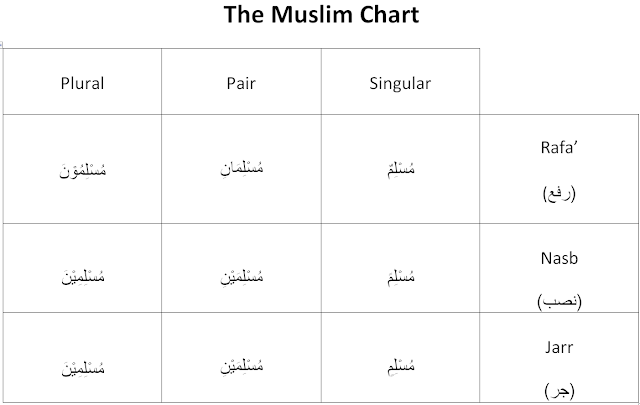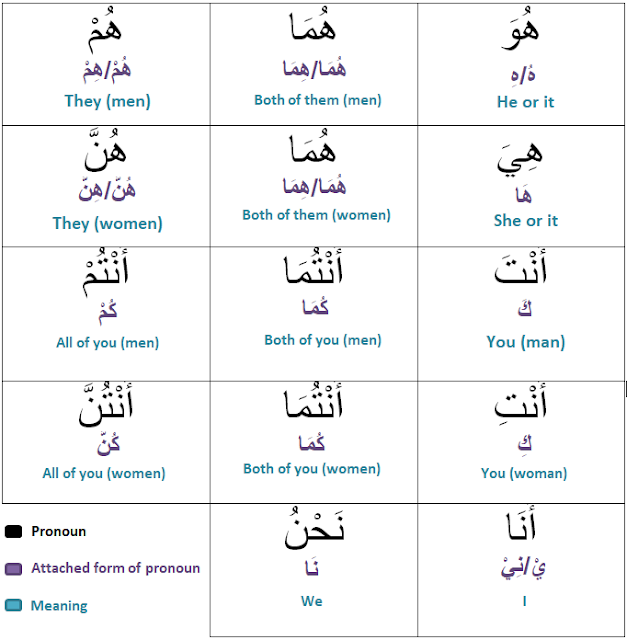Isms: Lesson 2 (Number)
As we have
seen in the previous lesson, isms (nouns) have 4 properties. They are:
1. Status:- rafa’
(doer), nasb (detail), jarr
2. Number
3. Gender
4. Type
The previous
day we learned in detail about status. Today we will be covering the next
property, ‘number’.
When it
comes to number of an ism, it’s somewhat like singular and plural in English.
But in Arabic, they have a third category called the pair. The chart below will
make it clear In Sha Allah.
Starting
from the first column on the right, ‘muslimun’ would mean 1 muslim in rafa’ form.
‘Musliman’ would mean 1 muslim in the nasb form. ‘Muslimin’ would mean
1 muslim in the jarr form. From the next column ‘muslimaani’ would mean 2
muslims in the rafa’ form, ‘muslimaini’ would mean 2 muslims in the nasb form
and the next ‘muslimaini’ would mean 2 muslims in the jarr form. (Nasb and jarr
have similar pattern in the pair and plural column)
It’s helpful
to have this chart memorized so that we are familiar with the ending sounds of
each column. To memorize, start with the singular column, then the pair, then
the plural. Recite it like, muslimun, musliman, muslimin, muslimaani,
muslimaini, muslimaini, muslimoona, muslimeena, muslimeena. Recite at least 5
times and see if you can do without looking.
After
memorizing, do the mental exercise below.
Exercise:
Look at the
words below and identify their status (rafa’, nasb or jarr) and number
(singular, pair or plural)
Note: the answer
for status maybe ‘nasb or jarr’ since nasb and jarr have a similar pattern in
pair and plural column.
فِيلٌ
بَحْرَينِ
بَنُوْنَ
نَفْسٍ
وَاحِدَةٍ
مُؤْمِنِيْنَ
مُكَذِّبُوْنَ
****************************************************************
ކުރީ ދުވަހުގެ ފިލާވަޅުގައި އަހަރުމެން ބެލި ފަދައިން
ކޮންމެ 'އިސްމް' (ނަމެއް) ގައި ވެސް 4 ސިފައެއްވެއެވެ. އެ 4 ސިފައަކީ:
މަޤާމް: ރަފަޢް (ކަންކުރާ ފަރާތް)، ނަޞްބް (ތަފްޞީލު)،
ޖަރް
ޢަދަދު
ޖިންސު
ވައްތަރު
ކުރީ ދުވަހު އަހަރުމެން ތަފްޞީލުކޮށް ކިޔެވީ 'މަޤާމް' އާއި
ބެހޭގޮތުންނެވެ. މިއަދު އަހަރުމެން އަލިއަޅުވާނީ އިސްމްއެއްގެ ދެވަނަ ސިފަ
ކަމަށްވާ 'ޢަދަދު' އަށެވެ.
ޢަރަބި
ބަހުގައި އިސްމްއެއްގެ ޢަދަދު ޢާއްމުގޮތެއްގައި ބަހާލެވެނީ 3 ބަޔަށެވެ. އެއީ مُفْرَد (އެކެއް)، مُثَنَّى (ދޭ) އަދި جَمْع (ދޭކަށްވުރެ ގިނަ)
އެވެ. ތިރީގައިވާ ތާވަލު ބަލާލުމުން މީތި ސާފުވާނެއެވެ. (އިން ޝާ ﷲ)
ކަނާތް ފަރާތުން ފަށައިގެން މުފްރަދް ގެ ރޮނގަށް ބަލާއިރު
'މުސްލިމުން' ގެ މާނައަކީ ރަފަޢް މަޤާމުގައި ހުރި އެއް މުސްލިމެވެ. 'މުސްލިމަން'
ގެ މާނައަކީ ނަޞްބް މަޤާމުގައި ހުރި އެއް މުސްލިމެވެ. 'މުސްލިމިން' ގެ މާނައަކީ
ޖަރް މަޤާމުގައި ހުރި އެއް މުސްލިމެވެ. މުޘައްނާގެ ރޮނގަށް ބަލާއިރު 'މުސްލިމާނި'
ގެ މާނައަކީ ރަފަޢް ގެ މަޤާމުގައި ތިބި ދެ މުސްލިމުންނެވެ. 'މުސްލިމައިނި' ގެ
މާނައަކީ ނަޞްބްގެ މަޤާމުގައި ތިބި ދެ މުސްލިމުންނެވެ. ދެވަނަ 'މުސްލިމައިނި' ގެ
މާނައަކީ ޖަރްގެ މަޤާމުގައި ތިބި ދެ މުސްލިމުންނެވެ. (މުޘައްނާއާއި ޖަމްޢުގެ
ރޮނގުގައި ނަޞްބް އާއި ޖަރްގެ މަޤާމުގައި ހުންނަ އިސްމްތައް ހުންނާނީ އެއްގޮތަކަށެވެ)
މި ތާވަލު ހިތުދަސްކޮށްފައި ހުރުމުން މީގެއިން ކޮންމެ
ރޮނގެއްގައި ހުންނަ އަޑުތަކަށް ފަރިތަވުމަށް ވަރަށް ބޮޑު އެހީއަކަށް
ވެގެންދާނެއެވެ. ހިތުދަސްކުރުމަށްޓަކައި ފުރަތަމަ މުފްރަދްގެ ރޮނގު ކިޔާށެވެ. ދެން
މުޘައްނާގެ ރޮނގެވެ. ދެން ޖަމްޢުގެ ރޮނގެވެ. ތާވަލު ބަލައިގެން މިގޮތަށް ކިޔާށެވެ.
މުސްލިމަން، މުސްލިމަން، މުސްލިމިން، މުސްލިމާނި، މުސްލިމައިނި، މުސްލިމައިނި،
މުސްލިމޫނަ، މުސްލިމީނަ، މުސްލިމީނަ މިހެންނެވެ. 5 ފަހަރު ބަލައިގެން ކިޔުމަށްފަހު
ނުބަލައި ކިޔޭތޯ ބަލާށެވެ.
ހިތުދަސްވުމުން ތިރީގައި މިވާ ފަރިތަކުރުން ހަދާށެވެ.
ފަރިތަކުރުން:
ތިރީގައި މިވާ ބަސްތަކަށް ބަލައި އެ ބަސްތަކުގެ މަޤާމާއި
(ރަފަޢް، ނަޞްބް، ޖަރް) އާއި ޢަދަދަކީ (މުފްރަދް، މުޘައްނާ، ޖަމްޢު) ކޮބައިކަމާމެދު
ވިސްނާށެވެ. މަޤާމުގެ ޖަވާބަކަށް 'ނަޞްބް ނޫނީ ޖަރް' އަންނަ ބަސްތައް ވެސް
ހުރެދާނެވެ.
فِيلٌ
بَحْرَينِ
بَنُوْنَ
نَفْسٍ
وَاحِدَةٍ
مُؤْمِنِيْنَ
مُكَذِّبُوْنَ




Comments
Post a Comment